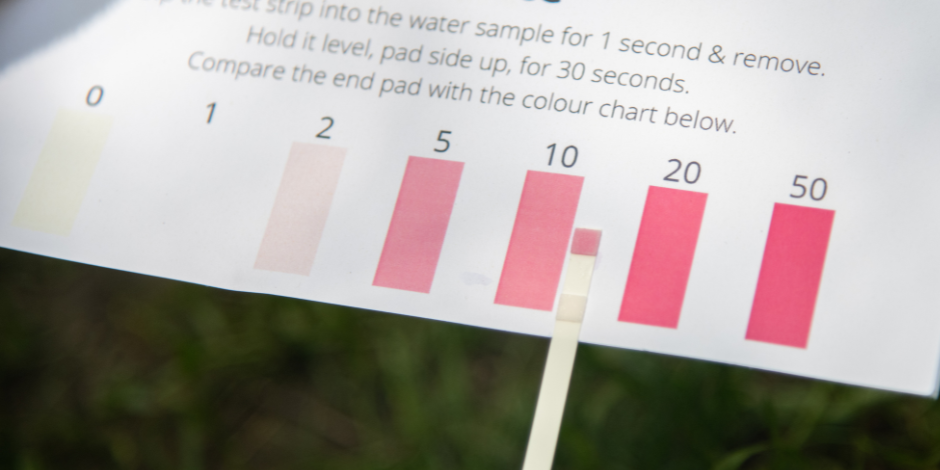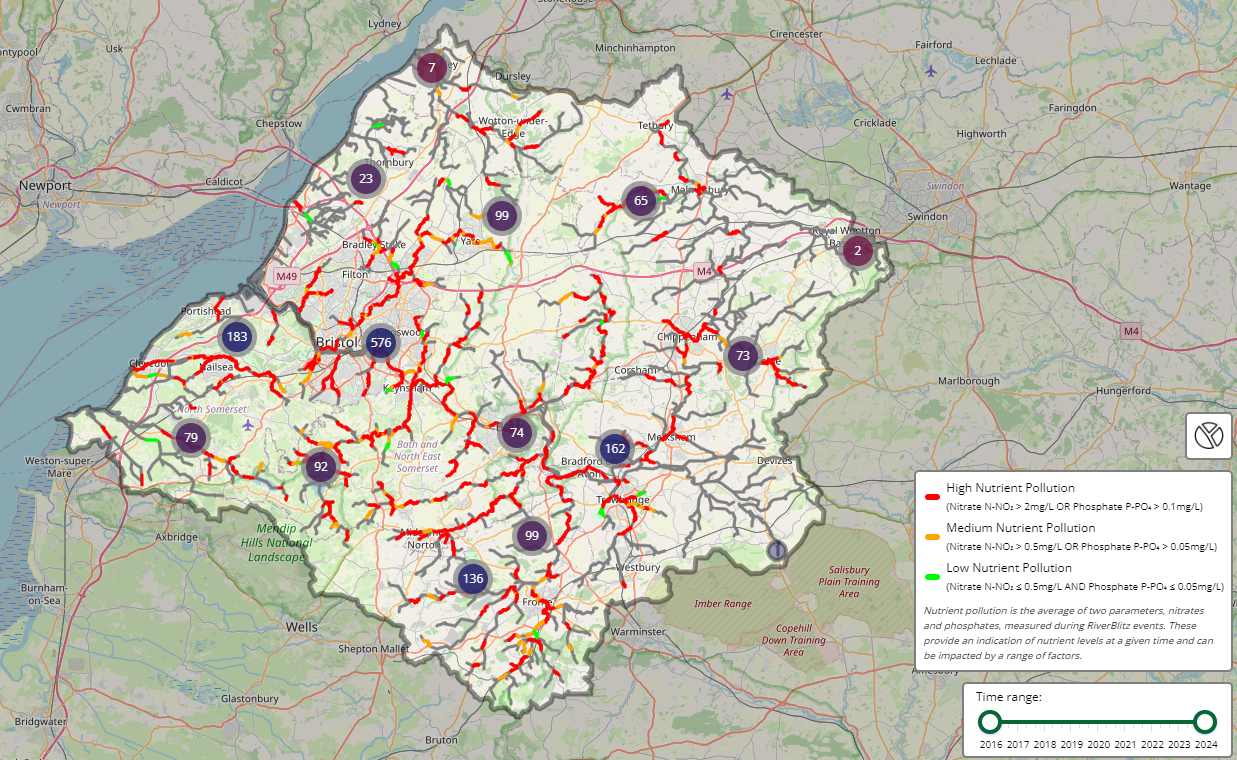Public awareness of the importance of freshwater quality to human health and wellbeing, environmental sustainability, climate resilience and economic prosperity continues to grow. More than ever before we are seeing public engagement in collective action and vision to ensure clean and safe water for future generations. Reflecting this, for the past nine years Bristol Avon Rivers Trust (BART) has invited a legion of volunteer citizen scientists to deliver the ‘Bristol Avon RiverBlitz’ to capture water quality data throughout the catchment. This year’s results have now been analysed and the results are in.
The 2024 RiverBlitz has been one of our largest to date, with 202 samples taken by 133 volunteers throughout the Bristol Avon catchment. Volunteers were provided with their easy-to-use water quality testing kits and headed out between the 5th and 14th July to take their samples, recording their data on BART’s RiverBlitz website portal.
The pollutants tested for were nitrate and phosphate, substances known as primary components of nutrient pollution, which persists in rivers and lakes across the Bristol Avon catchment. These are substances that mainly enter rivers from agricultural runoff, as fertiliser and animal waste leaching off fields and farms, and from wastewater pollution from sewage overflows. Domestic sources can also be significant in some contexts such as leaky septic tanks, sewage misconnections, garden waste and fertiliser misuse. Nitrate and phosphate are sampled because they are good indicators of general water quality in our rivers. Also, high levels of nutrients in freshwater ecosystems contribute to eutrophication, an overgrowth of single-celled algae. This causes toxic algal blooms and reduces oxygen levels, harming other aquatic life. Find out more about nutrient pollution in this excellent video: Phosphates: Too Much Of A Good Thing.
The Bristol Avon RiverBlitz reveals a snapshot of the whole catchment during one week of July. While this may not give us specific detail about individual streams and sites, over time as more RiverBlitz campaigns expand the dataset, it can give us a picture on trends in the Bristol Avon catchment. Rivers which are improving or those which are struggling are highlighted, helping us pinpoint areas to concentrate future conservation work to improve water quality. RiverBlitz 2024 revealed that 68.6% of sites sampled had high nutrient loads, while only 3.4% of sites sampled had low nutrient loading, which is an improvement compared to the last two years.
Graphs to show the proportion of sites with differing nutrient levels (phosphate and nitrate combined) across different time periods.
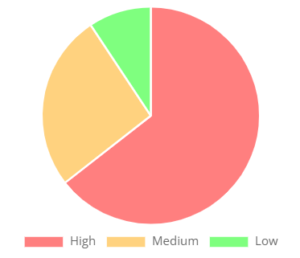
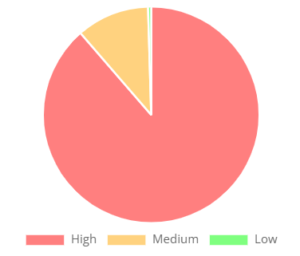
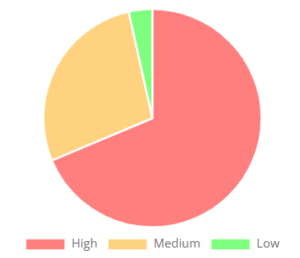
The 2022 and 2023 RiverBlitz revealed substantially fewer sites with low nutrient loading and substantially more sites with high nutrient loading compared to data from between 2018 and 2021. For example, in last year’s RiverBlitz, 88% of samples showed a high nutrient load and only one sample out of 290 showed low nutrient concentrations. Overall, urban rivers such as the Bristol Frome, Malago and Brislington Brook and those with large rural catchments such as the Wellow and Cam Brooks have been more likely to have high levels of nitrate and phosphate compared with small streams with rural catchments. This is because urban rivers are impacted by the pressures associated with high human population density and larger lowland rivers have more land they drain from and therefore have more sources of nutrient pollution.
Graphs to show the proportion of sites with differing nitrate and phosphate levels during RiverBlitz 2024
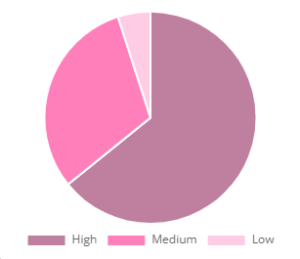
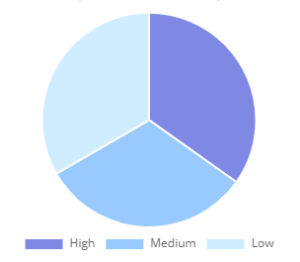
However, nutrient data can be influenced by a range of factors including weather conditions, temperature, and inputs from other connecting waters. It’s possible that 2022 and 2023’s more extreme summer temperatures and flashy heavy storms may have contributed to soil erosion and overland flow within the Avon catchment. Meanwhile, this year’s milder summer with frequent rain may mean that soils have remained moist and therefore better able to hold on to nitrogen and phosphorous may have contributed to relatively lower nutrient levels this year, particularly in smaller catchments.
Over the course of the RiverBlitz week, BART ran a few engagement activities, including a river dipping session with two classes of primary school aged children in Winford, Somerset. Children were invited to take part in water quality testing and learn to sample and identify freshwater invertebrates in their local brook. They were shown how this information can be used by BART to inform restoration activities. BART also hosted in person outreach events at Wiper and True brewery, inviting more people to pick up kits and take part in the RiverBlitz, as well as teaching them about the river.
Data for each watercourse collected since the first event in 2016 is accessible to the public via the Bristol Avon RiverBlitz visualization tool. This interactive map allows you to click on your local watercourse and see if it has high, medium or low levels of nitrate of phosphate.
We extend our heartfelt thanks to the Bristol Avon Catchment Partnership, Bristol Airport Community Fund, Schroder Charity Trust, Frognal Trust, Pilning & Severn Beach Parish Council, Avon Wildlife Trust, Wiltshire Wildlife Trust, Wiper & True and The Big Give for generously funding this year’s event.


